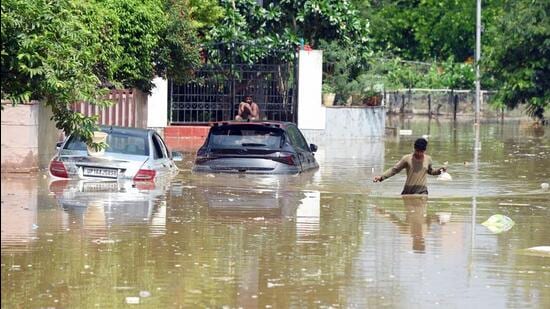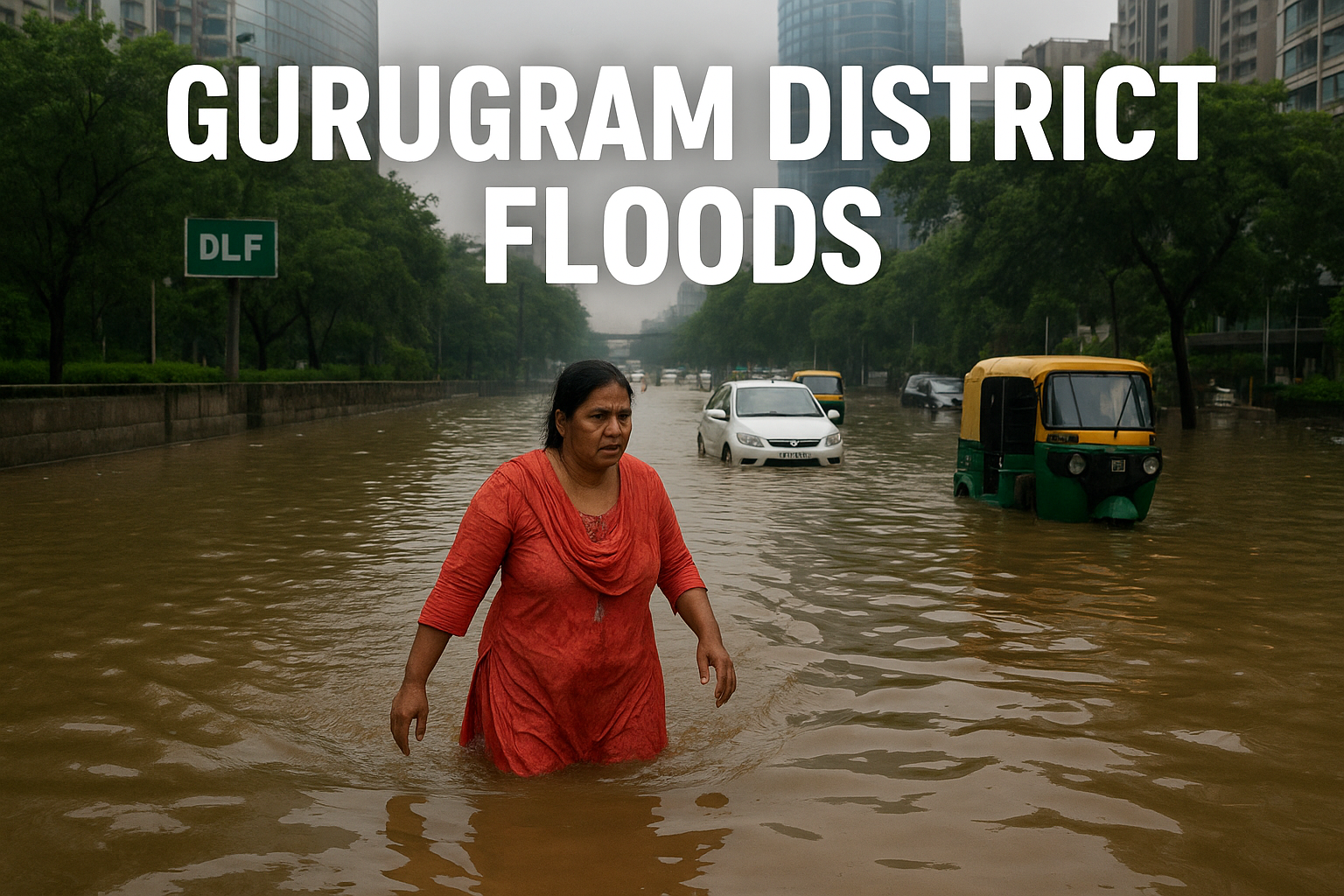Gurugram District Floods: Gurugram, once a quiet agricultural region of Haryana, has rapidly transformed into one of India’s most prominent corporate hubs. With its towering skyscrapers, luxury apartments, and bustling commercial zones, the city often symbolizes modern India’s progress. However, beneath this progress lies a growing concern that resurfaces almost every monsoon — the flooding of Gurugram district.
What was once an occasional inconvenience has now become a yearly struggle, exposing the gaps between rapid urbanization and sustainable development. The floods in Gurugram are not just about waterlogging; they highlight the city’s fragile infrastructure, environmental neglect, and the pressing need for long-term solutions.

Causes of Floods in Gurugram

Gurugram District Floods is a result of multiple interconnected factors:
- Rapid Urbanization Without Planning
Over the last two decades, Gurugram has witnessed explosive growth. Natural drainage systems, ponds, and wetlands that once absorbed rainwater have been replaced by concrete structures and highways. With limited open land left for percolation, rainwater has nowhere to go. - Encroachment on Natural Water Bodies
According to experts, many traditional ponds and drainage channels (locally called jhars or nallahs) have been filled up or built over. These channels were once the lifeline of the region, directing rainwater toward larger water bodies. Their absence now leads to waterlogging in low-lying areas. - Weak Drainage Infrastructure
The existing drainage network in Gurugram is not designed to handle the intensity of modern rainfall. In many areas, drains are clogged with debris, plastic waste, and construction material. This further slows down the outflow of water. - Climate Change and Unpredictable Rainfall
Climate change has increased the frequency of short, high-intensity rainfall events. Gurugram, with its unprepared infrastructure, struggles to cope with these sudden downpours.
The Human Impact in Gurugram District Floods
Floods in Gurugram are not just about disrupted traffic or submerged underpasses. They affect lives on multiple levels:
- Daily Struggles for Commuters: Offices in Cyber City and Udyog Vihar see thousands stranded in knee-deep water every monsoon. Cars break down, metro stations overflow with crowds, and traffic jams stretch for hours.
- Damage to Property: Housing societies in low-lying areas often face basement flooding, damaging vehicles and electrical systems. Residents are forced to spend heavily on repairs.
- Health Concerns: Stagnant water becomes a breeding ground for mosquitoes, increasing the risk of diseases such as dengue, malaria, and chikungunya.
- Impact on Migrant Workers: Daily wage laborers, security guards, and domestic workers face the hardest hit. Many lose days of income as floods disrupt transportation and work schedules.
Stories from the Ground for Gurugram District Floods
Take the case of Ritu Sharma, a working professional living in Sector 56. Every year, she battles flooded roads on her way to work. “It’s not just about getting delayed,” she says, “but the constant stress of whether my car will break down or I’ll be stranded for hours.”
For Rahul, an auto driver in Old Gurugram, floods mean a loss of earnings. “Nobody wants to sit in an auto when water is up to the seat level. On such days, I go home early with half my income gone,” he shares.
These small yet significant stories show that floods are not just about infrastructure but about real people struggling to adapt.
Government Response and Efforts
Authorities in Gurugram District Floods have acknowledged the problem and taken some measures:
- Drainage Improvement Projects: Several road stretches have been redesigned with better drainage, especially near Cyber Hub and Golf Course Road.
- Rainwater Harvesting Rules: New housing societies are mandated to set up rainwater harvesting systems.
- Pumping Stations: High-capacity pumps are deployed in flood-prone areas to drain excess water during heavy rains.
However, critics argue that these efforts are often reactive and temporary. Without long-term planning, floods keep returning each year.
Long-Term Solutions for Gurugram District Floods
Experts suggest that Gurugram needs a mix of infrastructure development and ecological restoration to tackle the flood crisis:
- Reviving Natural Water Bodies
Restoring ponds, lakes, and wetlands can significantly reduce waterlogging. Natural catchment areas should be protected instead of being encroached upon. - Strengthening Drainage Systems
Drains should be desilted regularly and designed to handle heavy rainfall. Smart stormwater management systems, already in use in cities like Singapore, can be explored. - Green Infrastructure
Creating more green zones, permeable pavements, and urban forests will allow better absorption of rainwater. - Strict Urban Planning
Construction in flood-prone areas should be regulated. Unauthorized encroachments must be cleared to ensure natural flow paths remain unobstructed. - Public Awareness
Residents and societies should be encouraged to adopt rainwater harvesting, avoid littering in drains, and participate in water conservation efforts.
Why Gurugram Floods Are a Wake-Up CallThe floods of Gurugram are not an isolated issue. They represent the challenges that many fast-growing cities in India face — a mismatch between rapid development and sustainable infrastructure. If ignored, the problem may worsen with increasing urban population and climate change.

Floods also remind us of the importance of balance. Cities must learn to grow without destroying their natural ecosystems. For Gurugram, this balance can decide whether it continues to thrive as a business capital or struggles every monsoon under the weight of its own growth.
Conclusion for Gurugram District Floods
The story of Gurugram District floods is more than just about waterlogging; it is a story of lessons in urban planning, climate resilience, and community effort. Addressing the crisis requires collaboration between the government, private builders, and citizens themselves.
Every flood is a reminder — development without sustainability is fragile. Gurugram has the potential to set an example by not just being a corporate hub but also a model of climate-smart urban living.
🌟 Positive Perspectives
- Increased Awareness – The floods have highlighted the urgent need to address Gurugram’s drainage and urban planning issues, pushing authorities to act faster.
- Community Spirit – Many residents, NGOs, and volunteers came forward to help flood-affected families, showcasing strong local unity.
- Government Action – Relief camps, rescue operations, and road repairs were initiated quickly in several areas, showing a proactive approach.
- Policy Push – The crisis is expected to drive long-term infrastructural reforms and sustainable urban development.
⚠️ Negative Perspectives
- Severe Waterlogging – Poor drainage and unplanned urbanization worsened the flood situation, leaving key roads and colonies submerged.
- Disruption of Daily Life – Schools, offices, and businesses were forced to shut down, causing economic losses.
- Traffic Chaos – Major roads, highways, and metro access points were blocked, trapping commuters for hours.
- Health Concerns – Stagnant water led to sanitation issues, increasing risks of waterborne diseases.
- Infrastructural Weakness – The floods exposed the city’s inability to handle heavy rainfall despite being a leading corporate hub.











